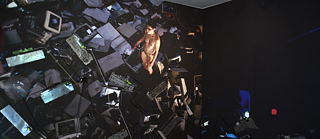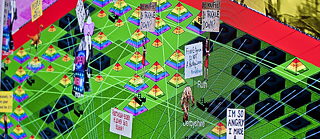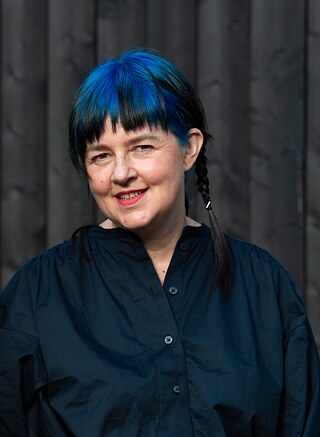Interview
"The sustainability of digitising artwork requires a holistic approach"

Ruth Catlow is the co-director of Furtherfield for art, technology and eco-social change, and co-principal Investigator at Serpentine Galleries' Blockchain Lab. For this article, we spoke to Ruth about “art action research”, the sustainable possibilities of digital exhibitions and the value of friendship.
By Lucy Rowan
You and Marc Garrett co-founded the Furtherfield Gallery based in Finsbury Park, London. Could you tell us more about how it got started and your work there?
Furtherfield has been going since 1996 when the web was getting started. Our spirit was guided by the kind of peer-led communities of the early, free and open-source software movement that saw the web as a place where we could build together outside commercial or proprietary interests, also outside of state interest.
In the early days, we understood that we could use this new emerging space as a place where artists, techies and activists could build the kind of infrastructure that would enable them to collaborate and make the kinds of cultures they wanted and needed. So it was kind of a utopian space.
Since 2011, we've run the gallery in the heart of Finsbury Park, which is a classic public park in North London. We've been running our first gallery since about 2004 with a dedication to artists focused on decentralisation and the impacts of decentralised tech on society, paying attention to how it was changing our relationships with each other, and how it changed the way power was operating and flowing.
It always felt very important to us to open a gallery because whilst a lot of the exchange and production was happening in a virtual online space, bringing people together in a physical space enabled them to understand the impact of the work and to deliver it fully to a cultural audience. By moving to a public park, we multiplied our audience by a factor of 10 and probably opened up our audience to a much more diverse one since it's in London. An audience that typically wasn't necessarily already tuned into this style of “high art”.
So we started by curating exhibitions that brought in works that were doing critical thinking about this intersection between art technology and social change by people who we consider to be really smart, amazing creative thinkers and practitioners. Once we pulled this into the public space, we worked to make it accessible for anyone who walked through the door. This might include people who were out walking their dogs, people bringing their children to play or simply someone hanging out smoking on the bench. The aim was to make it important and relevant to anyone who might stumble in. It was a fantastic and interesting challenge for curators.
More recently, we changed the way we worked because after all this time in the park, we were learning so much and spending so much more time with different local people, we understood that our online network communities had just as much to learn from the insights, lived experience and creativity of the people that we were on the ground. So we wanted to start doing participatory work.
Is this what is meant by your concept of “art action research”? What does it mean for local communities?
Over the last five years, we've been putting more resources into a project that focuses on the histories and interests of our local communities. Not only did we want to co-create the work, but also to choose which works get a platform and which things get promoted. So “art action research” is essentially an interactive process where we work with people to find out what matters to them in that particular place, co-producing work and working out ways to do that in a way that is meaningful to them. Then we work out where to put our focus and which things to promote. Through this process, we also learn how to talk about this to include and involve more people.
Since 2017/18, one of the Web3 projects we’ve been working on is called Culture State. This is a Blockchain-based quadratic voting app for collective cultural decision-making. It was inspired by two things. Firstly, by Brexit and the horror of a referendum that completely split the country whilst telling us nothing about our culture other than putting us actually in direct conflict with each other. Secondly, as a response to the 50,000 people who use this park. There are 200 different languages spoken by the people who use this park. So we thought, how do we start to think about making decisions together or learning about each other? The app uses quadratic voting, which allows people to make decisions and express the intensity of their decisions. This way people can have opinions on things they really care about.
Once people have chosen the things they would like us to commission or to work on, they can tell us more about why those things are important to them. This data is then stored permanently and can be referred to by anyone so that we can see each other together. It's basically like putting more information into a kind of data commons for the local community. The idea is for this app to be used in lots of different settings where people get to set their own questions and get to build their own cultural data commons, as a way to build community confidence, and build a kind of investment in cultural decision-making and localities. It’s still in the early days since software development is already hard, but in an arts organisation, it is a nightmare.
Another example: we're developing live-action role play as a core art action research methodology. This often allows us to work with specialist researchers on topics around decentralisation or ecology. These are our kind of two questions to kind of focus on at the moment, and to work with the people whose lives are affected by these topics. It's a way to engage deeper with the public to find out what is at the heart of some of these research processes and topics.
For the last two to three years, we've been working on a live-action role-play called ‘The Treaty of Finsbury Park’, which is an interspecies justice project. It’s a future fiction, in which all living beings can understand each other and all the species are now lobbying for equal rights with humans. And so through that, we've run a series of festivals, which is a way of bringing people together into a very unusual expansion of our ideas of what's possible. Then we decide on a new world that we could build together. When people have these experiences, their sense of the place is really changed, and their sense of their own agency within these places is impacted.
Last year, you launched the Radical Friends book at the Serpentine Gallery. The book states: “The technology of the future needs to be about “togetherness, not separation. Love, not suspicion. A common future, not isolation.” For those who haven’t had the chance to read this, could you explain what is meant by this?
We called the book Radical Friends because of the significance of decentralisation in the disintermediation financial future and a disintermediation future of governance. At the moment, this is really kind of like in Web3 - it's in the hands of marketers and developers. So our core message in Radical Friends is that we actually need to ensure whilst we are building this very important infrastructure, that we put values at the heart of our work in the shared interests of as many people as possible.
We saw friendship as a core value in all human societies and it is well understood. It's the thing that motivates you to try and solve a really hard problem with someone who is from a different background from you. It’s a way for us to learn together. But it's also a good “North Star'' when we're thinking about infrastructure. Especially when we're thinking about the kind of violence that is done by our current global political infrastructures by state religious patriarchy, it provides us with a very clear alternative. It’s kind of a modality to keep in mind when we're developing new tech or new governance methods.

This raises a bunch of interconnected questions of access, preservation, ownership, and environmental impact - all wrapped up in a wider question about how digital cultural infrastructures that are unfair and exclusive might be regarded as sustainable. The embedding of technology into cultural landscapes can be problematic. For instance, digitising public art collections might enhance access, increase opportunities for both research and innovation, as well as benefit education and engagement with art.
However, many of the big cultural digitisation projects are now carried out in partnership with monopolistic mega-corporations whose missions, priorities, and life cycles sit in direct tension with those of cultural institutions. If the corporations’ interests change or if they cease to support the project then the accessibility and preservation of digitised materials might be jeopardised.
If we agree that an important role of cultural institutions is to reflect the distinct subjectivities of communities of place, time, or practice concerning wider society, then platform interfaces impose a problematic “one world” homogeneity with strong, often hidden, brand missions, that promote, for example, the status of digital images as products to be exploited, or people as users, rather than citizens. This not only presents an oppressively extractive, centralised, consumerist model of society, but it also perpetuates colonial notions of cultural possession.
Do you have any suggestions on how it could be improved?
One way to address this would be to fix the ongoing disconnect between the cultural “establishment” and the incredibly fertile 30-plus years tradition of artistic practices that engage critically with computer technologies as media, distribution infrastructure, and topics for reflections on power.
Since the early nineties, artists have been self-organising for emancipation from different aspects of oppression at play in digital network technologies such as patriarchy (VNS Matrix, Old Boys Network), proprietorial control (Critical Engineering Working Group, Marc Garrett, Antonio Roberts, Eugenio Tisselli, Piratbyrån), colonialism (Nora Al-Badri & Jan Nikolai Nelles, Looty, Gretta Louw with Warnayaka Art Centre, Mongrel), environmental impacts (Memo Atken, Sarah Friend, Joana Moll, Julian Oliver), and identity-based and bio-oppression (Shu Lea Cheang, Zach Blas, Mary Maggic). Organised in place or by affinity this self-reflexive artistic engagement with tech reveals “the layers of value and politics of cultural heritage”, is shaped to local and trans-local cultural needs and enquiries, and generates strategies to mitigate potential harms.
The sustainability of digitising artwork requires a holistic approach informed by distributed communities of peers who together can consider environmental, technological, and social factors and create a more sustainable and equitable digital art ecosystem for the future.
Are digital exhibitions better for the environment than classical ones?
Digital exhibitions may decrease the resource-intensive aspects of traditional exhibitions, such as transportation, printing, and physical infrastructure. However, the sustainability of digital exhibitions depends on a complex array of factors like energy sources, e-waste management, the carbon footprint of data centres, and the eco-social harm done by the extraction of raw materials often in the Global South. Projects like The Networked Condition, produced by a group of conscientious UK digital arts organisations concerned with exactly this issue are now looking at the “often-hidden environmental impact of the creation and delivery of artworks using digital technology”. They have created a tool to help people plan their live-streamed events, digital artworks or digital events with their carbon footprint in mind.
Fundamentally though, it would be better for the environment if all global economies did not operate on profit and growth models reliant on fossil fuels, the exploitation of all earth's resources, and the annihilation of cultures that circulate value in different ways. I agree with the Sunlight Doesn’t Need a Pipeline (SDNP) coalition led by Dani Admiss that the climate emergency is as much a social and political problem, as an environmental one. Therefore, if we are interested in the environmental impact of arts it might be better to ask "by who and for whom is the art made?" to shift attention from the commodity value of art in both digital and “traditional” spheres. Art that agitates against harmful social and economic systems, and instead cares for and generates value in and for communities. The SDNP’s holistic and ever-growing decarbonisation plan for the art sector and beyond provides an excellent example of how this might look.
